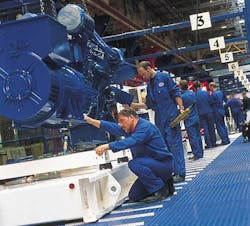Reconsidering the Human Side of Automated Production
Though the movement to re-shore manufacturing operations is gaining a great deal of attention, the reality is that these projects represent only a small portion of the jobs that have been offshored over the past few decades. Statistics aside, the standout issue for those manufacturers in developed countries that never offshored — as well as those that have — is that the manufacturing industries are simply not viewed by many in the Western world as the most desirable place to work.
To remedy that, a great deal of work is being done by industry to demonstrate that manufacturing is no longer the dreary, dirty, dangerous line of work it has long been perceived as. Much of this work has been done by manufacturers themselves to improve working conditions and production process, but the production processes themselves, in many cases, still leave a great deal of room for improvement.
In new research, Tom McNamara & Sarah Hudson, of ESC Rennes School of Business, France, along with Sabry Shaaban of ESC La Rochelle, France, have sought to address the questions: How best to design production? Where can costs be cut and efficiency gained? How can line managers think best about line design in an environment, where demand fluctuates, machines break down and human beings work at different paces and with diverse efficiency? Is there anything new that can be done after the cost-cutting, streamlining and the mechanization of the last three decades?
Their research suggests that manufacturing performance can be improved by using “un-paced production lines in which workers are allowed to work at their own speed, passing on work pieces to the next station, without the aid of an automated moving line… This allows for smoother production by avoiding the stoppage of work due to an operator not having a work piece available, or not being able to pass on a piece due to there being no room for it after the station. The importance of these buffers should not be underestimated since they allow workers to process items independently of each other.”
This line of thinking, of course, runs counter to the more widely used “balanced line” approach where each work station is expected to take the same amount of time to perform a given task before having it move on to the next operator. McNamara, Hudson and Shaaban say that the balanced line approach is “impossible to achieve” due to the type of work being done, technological or precedence restrictions, and human nature being reflective of different levels of training, education, skill, ability, and motivation.
Variation in the time taken by an operator to complete a task can also be quite considerable, according to the researchers. “People in general cannot perform a task or a series of tasks differing in complexity and specificity again and again at exactly the same speed over a length of time. Research has shown that the average time to complete a task can vary by up to 66 percent over a day. Add to this the fact that lines breakdown, or an operator may need to stop unexpectedly, and we see that aiming for a balanced manual line, where a product moves unfailingly from one step to the next with mechanical precision, becomes increasingly unlikely.”
The bottom line to the research conducted by McNamara, Hudson, and Shaaban (the details of which can be read here) is that “the amount of time it takes for different operators to complete the exact same task will never be equal. Contrary to popular opinion, this is not necessarily a bad thing. Studies have shown that manual lines can be from 25 to 75 percent more efficient than fully automated lines. Furthermore, “the prospect of being able to allow for the natural rhythms and fluctuations of human work and the inevitable downtime that lines suffer while also improving efficiency makes both financial and moral sense.”
Though I am not familiar with any highly automated company putting this un-paced production theory to the test, it certainly would be a departure from the norm in many manufacturing environments.
Is it realistic for automation and un-paced production to co-exist in today’s fast paced business world as the researchers suggest? What’s your take on its viability?
About the Author
David Greenfield, editor in chief
Editor in Chief

Leaders relevant to this article:
